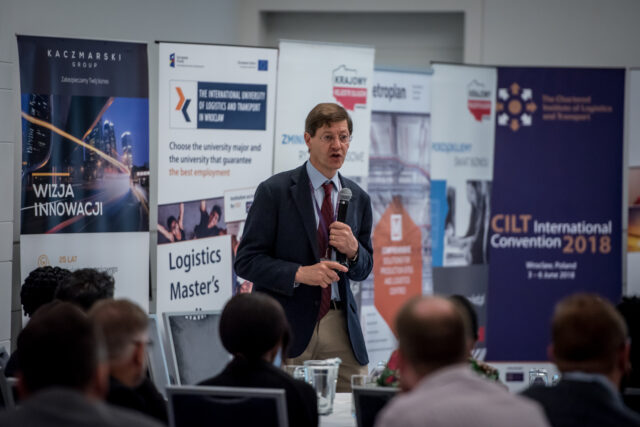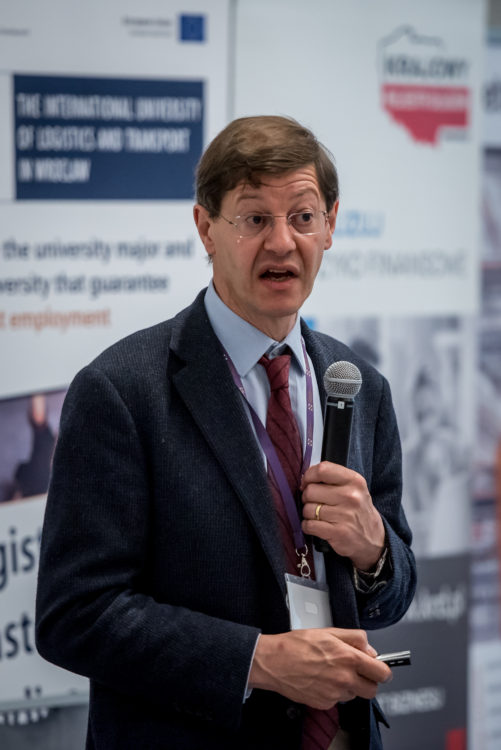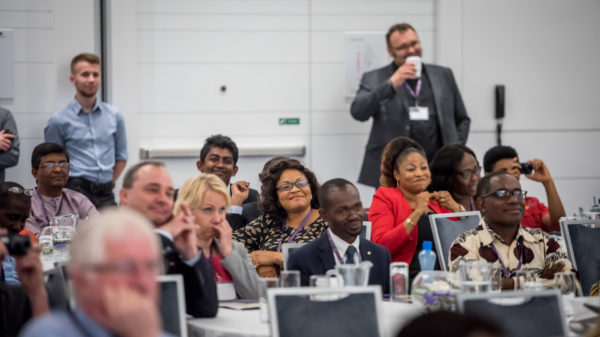Logistics for the Low Carbon Age

The great promise of the electric vehicle is a pathway to Sustainable Transport. At CILT International Convention in Wroclaw, Professor David Cebon of the Centre for Sustainable Road Freight examined the potential and realities of the electric vehicle, and the challenges in creating a zero-emission transport network.
‘We’re focused entirely on trying to decarbonise road freight.’ Professor Cebon opened his presentation by explaining that mainstream adoption of decarbonising interventions is only way to achieve a significant reduction in greenhouse gases. ‘If you have an intervention for decarbonising a vehicle, it’s only useful if industry adopts it widely. If an individual operator adopts some miracle solution that cuts their carbon footprint completely, it doesn’t actually help the planet. It only helps the planet if the industry as a whole can take up the intervention.’
Using a graph onto which he had mapped reduction of greenhouse gasses on one axis and what he calls ‘barriers to mainstream adoption’ on the other, Professor Cebon evaluated the costs and benefits of a range of interventions, such tyre pressure monitoring and driver training. ‘It’s very important to think about the barriers to these things before investing in them…they can be technical, that is the technology doesn’t work well enough, they can be economic – it’s too expensive, and they can be political meaning that society or politicians aren’t willing to…take on those technologies.’
Many of the low barrier measures are already being widely deployed. ‘There’s a lot of aerodynamic treatments of trucks…you can reduce the vehicle’s weight, you can improve refrigeration technologies, you can use low rolling resistance tyres, more efficient diesel engines…you know you can spend a few billion euros, pounds or dollars on improving the efficiency of a diesel engine and you will only get a few percent of benefit. Nevertheless it is something that is doable and is being done by manufacturers all the time.’

Biogas is for Professor Cebon one of the most promising avenues, but it still has limits. ‘It’s very interesting. We can get bio-methane from landfill, we can get it from the anaerobic digestion of waste, it’s a great near-zero carbon fuel…The problem with it is there’s not nearly enough bio-methane to…run all our trucks on it. Rather more sensible, is to just add that bio-methane to the gas grid, use gas-powered vehicles which are already about 10 – 12% better, and get the benefit of a decarbonised gas grid.’
For Professor Cebon the most important avenue to pursue is the electrification of all long-haul vehicles. ‘The long-haul is where most energy is used. If you can electrify long-haul vehicles, that is the big prize in decarbonisation.’ In his mind it also possible, and begins with national and regional distribution centres connected to major roads. ‘If we think about cities being connected to the motorway network, one of the things which is often the case is you have supermarkets on the edge of town, you have land on the edge of town where you can do urban and local consolidation centres.’
At this point, you can turn over the last-mile delivery of food, the majority of cargo going in to a city, to an electrified fleet, and in doing so remove one of Professor Cebon’s least favourite vehicles, the private car. ‘It’s perfectly possible to do battery-powered home delivery for example of groceries, one of the really big impact items for last mile…we can have battery-powered vehicles doing lots of stops, taking off the road all of those very-efficient inefficient passenger cars which are the least efficient freight vehicles known to man. A passenger vehicle weighs one and a half to two tonnes and carries a few kilograms of cargo – two shopping bags. A completely ridiculous way to do efficient freight.’
Professor Cebon is clear that electrification of the urban freight network, including things like bin collection is all possible now, especially with the of addition charging stations around the environment, allowing vehicles can do what is called opportunity charging. The real challenge lies in electrification of the trunk road network. ‘There are a few solutions around…this is an overhead system promoted by Siemens’, says Professor Cebon, indicating a slide. ‘It’s a practical and low-cost solution. In fact, these wires could be put in across the entire motorway network of the UK for a third of the cost of the HS2 rail project.’

Importantly, this possibility exists without needing to improve battery technology. ‘All the batteries on all of these vehicles are less than about 85 kilowatt hours, and that’s about the size of a Tesla Model S. So if you do proper charging…you can electrify road freight.’ Indeed, it is the charging strategy that is key. ‘The advantage of opportunity charging is it uses smaller, lighter, cheaper batteries. Batteries are very expensive, and they are very heavy. It allows you to carry more payload, it allows you to have lower CO2 emissions per payload as a result…and it gives you much smaller charging infrastructure requirements. You don’t have to have depots with megawatts of charging capability; you can have depots that do small amounts of charging overnight.’
For Professor Cebon, the electrification of freight is not just possible, it is essential if nations are to meet global carbon reduction targets. ‘80% CO2 reduction is only achievable with electrification of most heavy goods vehicles.’ It is possible through a combination of opportunity charging strategies and overhead wires, all proven technologies, and therefore the challenge presented is not one of innovation, but of infrastructure. ‘A new era of infrastructure investment is required, charging infrastructure for vehicles. We need to be thinking in those terms, local authorities need to thinking about putting opportunity charging in cities, and highway agencies need to be thinking about projects for the electrification of highways. Otherwise we can’t get to the 80% target.’
David Cebon is a Professor of Mechanical Engineering in Cambridge University and a Fellow of the Royal Academy of Engineering. He is Director of the Cambridge Vehicle Dynamics Consortium and the Centre for Sustainable Road Freight, and he leads Cambridge University Engineering Department’s Transport Research Group
CILT International Convention ran this year from the 3rd to the 6th of June under the twin themes of Linking CEE to the World and The Electric Car Revolution and its Impact on Logistics. Delegates enjoyed an exciting 4-day programme, including presentations by Professor Hugo De Campos of the Mike Ilitch Business School, WiLAT Global Advisor Dr Dorothy Chan, Professor René de Koster of the Rotterdam School of Management, and Chris Jones, Vice-President and Chief Analyst at Canalys.

You can catch up on this and other presentations via our Facebook videos page. The PowerPoint presentations from International Convention are also available on our SlideShare page.
Next year we will be in Manchester for International Convention 2019. Organised under the theme of Global Solutions to Global Challenges, Industry 4.0, Future Leaders (YPs), and Women in Logistics and Transport (WiLAT) will be at the heart of International Convention 2019. Join us there to celebrate our centenary, and help shape the next 100 years of our Institute and our industry.